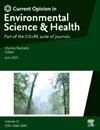Groundwater arsenic pollution in Vietnam: Current opinion on the mobilization and remediation
IF 6.7
Q1 ENVIRONMENTAL SCIENCES
Current Opinion in Environmental Science and Health
Pub Date : 2025-01-15
DOI:10.1016/j.coesh.2025.100596
引用次数: 0
Abstract
Arsenic, the 20th most abundant element in the Earth's crust, is a significant environmental and health concern, prominently featured on priority lists of hazardous substances. Due to its high mobilization and persistence in both natural and anthropogenic environments, chronic exposure to arsenic in groundwater has posed severe public health risks. This review focuses on the current status of arsenic contamination, the release mechanism, the mobilization, and remediation of arsenic-polluted groundwater in major river deltas in Vietnam. The most arsenic-polluted regions in Vietnam are the Red River Delta (up to 3050 μg/L) and the Mekong River Delta (up to 1351 μg/L), far exceeding the permissible limit value of the World Health Organization (WHO) guidelines for arsenic in groundwater at 10 μg/L. Arsenic levels are unevenly distributed due to the differences in the geochemical composition of the aquifer and hydrological flow patterns. Utilizing natural laterite adsorption is proposed as a remediation strategy to limit the risks of arsenic spread in groundwater and its impact on public health.
越南地下水砷污染:目前对动员和修复的看法
砷是地壳中含量第20多的元素,是一个重大的环境和健康问题,在危险物质优先清单中占有突出地位。由于其在自然和人为环境中的高度动员和持久性,长期接触地下水中的砷已构成严重的公共健康风险。本文综述了越南主要河流三角洲地下水砷污染现状、砷释放机制、砷污染的动员和修复措施。越南砷污染最严重的地区是红河三角洲(高达3050 μg/L)和湄公河三角洲(高达1351 μg/L),远远超过世界卫生组织(世卫组织)地下水砷含量准则的允许极限值,即10 μg/L。由于含水层的地球化学成分和水文流动模式的差异,砷含量分布不均匀。建议利用天然红土吸附作为一种补救策略,以限制砷在地下水中扩散的风险及其对公众健康的影响。
本文章由计算机程序翻译,如有差异,请以英文原文为准。
求助全文
约1分钟内获得全文
求助全文
来源期刊

Current Opinion in Environmental Science and Health
Medicine-Public Health, Environmental and Occupational Health
CiteScore
14.90
自引率
0.00%
发文量
92
审稿时长
114 days
 求助内容:
求助内容: 应助结果提醒方式:
应助结果提醒方式:


